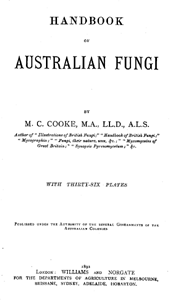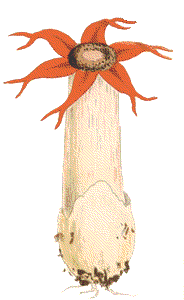|
|
The study of Australian fungi
Before the twentieth century
The stinkhorn Aseroe rubra was the first species of fungus to be collected and described from Australia. Jacques Labillardière (1755-1834), a member of the D'Entrecasteaux expedition, collected the specimen on 1 May 1792 at Recherche Bay in southern Tasmania and published an account of it in 1800.
Before that John White, one of the first English settlers of Australia, had commented in passing on a local mushroom in his Journal of a Voyage to New South Wales, published in 1790. That level of comment was to remain the norm for the first few decades of European settlement. While considerable attention was given to Australian plants in those decades, the fungi were virtually neglected. Very few people collected or painted fungi and some of this early material has been lost. Various explorers, settlers and visiting botanists mentioned fungi in their letters or journals - but mostly in passing, sometimes commenting on edibility or native use, and usually with not enough detail to allow identification of the species they saw.
The botanist Robert Brown (1773-1858) and the artist Ferdinand Bauer (1760-1826) accompanied Matthew Flinders on the Investigator expedition of 1801-1803. Brown may have collected a few fungal specimens and noted others, but many collections from that expedition were lost in a shipwreck. In an appendix to Flinders' A Voyage to Terra Australis, which appeared in 1814, Brown listed ten fungal species. Of the 256 paintings completed by Bauer, six were of fungi.
The Reverend Miles Joseph Berkeley (1803-1899) was the pre-eminent English mycologist for a large part of the 1800s, and did much to document the non-European species as well. In 1839 he published the first of his papers dealing with Australian fungi. His paper was based on Tasmanian collections sent to the Royal Botanic Gardens at Kew in London by Robert Lawrence and Ronald Gunn . Lawrence and Gunn were two of the botanical collectors recruited by William Hooker, Professor of Botany at Glasgow University and later director of the Royal Botanic Gardens at Kew. Hooker established a worldwide network of correspondents and collectors, so that in the heyday of the British Empire numerous specimens flowed into the Kew gardens from all parts of the world.
Berkeley's 1839 paper was the first taxonomic treatment of Australian fungi
by an English mycologist - 50 years after the English settlement! He published
on Australian fungi over the next five decades, describing numerous new species.
Of course, he struck numerous problems since he was in England and the Australian
specimens had first to be dried properly and then kept dry during the long sea
voyage, to prevent them moulding away. Even if kept dry and mould-free, the
specimens were still subject to insect attack. ![]() Many
specimens did succumb to mould or insects and in one paper Berkeley commented
that the list of species would have been much longer "had not the notes
been lost and the specimens much corroded by insects".
Many
specimens did succumb to mould or insects and in one paper Berkeley commented
that the list of species would have been much longer "had not the notes
been lost and the specimens much corroded by insects".
Joseph Hooker, the son of William, visited Tasmania in 1840-1841 as part of the Erebus and Terror expedition and undertook some collecting trips with Gunn. Berkeley wrote the fungal section of Joseph Hooker's 1859 Flora Tasmaniae. While Berkeley used the collections of Gunn, Lawrence and Joseph Hooker in this work, most of the new species recorded there were based on the collections of William Archer. Gunn and Archer were prolific collectors over many years and as recognition of their efforts, Berkeley named several species in their honour.
| Cyttaria gunnii | |
| Cordyceps gunnii | |
| Anthurus archeri | |
| Cortinarius archeri |
William Hooker had also established a productive, long-term association with James Drummond (1784-1863) of Western Australia. While the bulk of Drummond's collections were of flowering plants, he collected over 200 fungi (though not all have survived) and Berkeley described over 50 new species based on Drummond's collections.
In the first half of the 19th century the only other major contributor to Australian mycology was Elias Magnus Fries (1794-1878), sometimes called the "Father of Mycology". He received a collection of Australian fungi from Johann Preiss (1811-1883), who collected botanical specimens in Western Australia from late 1838 to early 1842, sometimes in company with Drummond. While Preiss collected several thousand specimens in all, only about 40 were fungi.
Ferdinand von Mueller (1825-1896) migrated from Germany to South Australia in 1847 and in 1853 was appointed Government Botanist of Victoria. Through almost 50 years of effort, he made an unparalleled contribution to Australian botany. In his earlier years he was an indefatigable collector, through many parts of Australia, and in his later years received numerous plant and fungal specimens from his network of amateur collectors, scattered throughout the continent. While Mueller sent fungi to Berkeley at Kew, he also sent specimens to mycologists in continental Europe - such as the Austro-Hungarian Karoly Kalchbrenner (1807-1886); the Italians Pier Andrea Saccardo (1845-1920), Giacomo Bresadola (1847-1929) and Augusto Berlese (1864-1903); Eduard Fischer (1861-1939) in Switzerland and Georg Winter (1848-1887) in Germany.
Between 1857 and 1859 the Austrian navy's frigate Novara circumnavigated the world with a party of scientific researchers. The expedition had been authorized by the Austrian archduke and much of the preparatory work was done by the academy of science in Vienna. The expedition stopped in Sydney in November-December of 1858 and during that time collected six species of fungi in the Sydney region. An account of the expedition's botanical findings was published in 1870 under the title Reise der Österreichischen Fregatte Novara um die Erde in den Jahren 1857-1859 unter der Befehlen des Commodore B. von Wullerstorf-Urbair, Botanischer Theil, edited by Eduard Fenzl. The chapter that included the fungi was written by Heinrich Wilhelm Reichardt.

Mordecai
Cubitt Cooke (1825-1914), who took over Berkeley's role in England, was
another of the European mycologists with an interest in non-European species.
Cooke and his compatriot George
Massee (1850-1917) described the bulk of the new species found in the specimens
Mueller sent to Kew and published their results in a series of papers. Cooke
gathered all the available information about Australian fungi in his monograph,
Handbook of Australian Fungi, which appeared in 1892. This was the first
comprehensive account on the Australian fungi and gave brief descriptions of
all the species thus far found in Australia. Cooke had the immense resources
of the Kew herbarium at his disposal, as well as contacts with the other European
mycologists who had worked on Australian material. It would therefore be natural
to expect that his book gave a solid foundation for the future study of Australian
fungi. Alas, no. One mycologist has described the book as "somewhat unsatisfactory",
and that appears to be the most flattering appraisal. To be fair to Cooke, he
was forced to work with dried material that had to survive the sea voyage to
England - and he was able to use only about 10% of the material that was despatched
from Australia. The specimens were often accompanied by, at best, limited descriptions
of the fresh appearance. Cooke commented on these difficulties and noted that
without accompanying notes or sketches "errors are almost inevitable".
Puffballs and many of the bracket fungi, for example, change little on drying
but for the fleshy fungi, especially the mushrooms, good descriptions of the
fresh state are essential. So, while there are many pages of coloured illustrations,
at times there is only a tenuous connection between the drawing and the living
fungus. ![]() Moreover,
the verbal descriptions are far too brief. It has always been difficult to use
Cooke's book to identify Australian collections.
Moreover,
the verbal descriptions are far too brief. It has always been difficult to use
Cooke's book to identify Australian collections.
|
|
 |
|
Frederick Bailey (1827-1915) was the Queensland Colonial Botanist from 1881 until his death. Like his contemporary von Mueller, Bailey collected numerous specimens of his own and also had a network of collectors, scattered through Queensland and New Guinea. The initial recipient of his fungal specimens was the Englishman Christopher Broome (1812-1886), a close collaborator of Berkeley's. In later years Bailey despatched his specimens to Cooke and then to Massee after Cooke stopped publishing on Australian fungi in the mid 1890s.
Thus, in the second half of the nineteenth century there were solid connections
between Australian botanists and collectors, and the mycologists of Europe.
While some new species had been described by some of the Australian botanists,
the more common practice was to send specimens to Europe for study and publication
there. While non-English mycologists participated in the mycological exploration
of Australia, the bulk of the work was done in England. This is not surprising,
given the English settlement of Australia. For example, if we look at just the
mushrooms, then 98% of the new species described from Australian material were
published by the English mycologists. Given the propensity for much of the 1800's
material to be sent to England, the bulk of the Australian type collections
from that century are housed in the Kew herbarium.
Other History Pages
![An Australian Government Initiative [logo]](/images/austgovt_brown_90px.gif)




